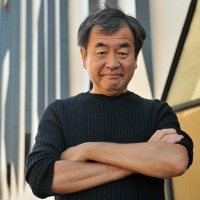The winning proposal by Kengo Kuma, formerly known as design A, was submitted by a team comprised of an architect, construction firm Taisei Corp. and construction support firm Azusa Sekkei Co. It features a roof made of wood and steel for a design that draws on traditional Japanese architecture.
It has already been dubbed the “hamburger” on social media in Japan.
The Japan Sport Council (JSC), which is overseeing the construction project, will finalize the contract with the winning party next month and plans to start construction as early as December 2016. All construction is scheduled to finish by November 2019 so that the stadium will be ready for the Olympics opening ceremony in July 2020.
The winning design received 610 points. The other design, identified previously as design B which turned out Friday to have been put forward by a venture comprised of architect Toyo Ito and construction firms Takenaka Corp., Shimizu Corp. and Obayashi Corp., lost with 602 points.
Architect and critic Takashi Moriyama said the 27-point difference could be attributed to the panel taking a cautious stance so as to avoid making the same mistake as was made in July.
Moriyama said.- “Design B proposed an unprecedented method for construction (to shorten the building period) by using new materials to build the stadium, whereas design A proposed using a more orthodox method that is familiar to everyone … I believe the judges assessed design A as being less risky.”
Dame Zaha Hadid, fighting for a second chance for her redesigned submission until the very last minute, reacted swiftly and issued an expectedly disappointed statement on her website.-
“We were honoured to be selected to design a stadium that would enable Japan to welcome the world for the 2019 Rugby World Cup and bring the 2020 Olympic Games to Tokyo, before becoming a new home for Japanese sport for many future generations.
Sadly the Japanese authorities, with the support of some of those from our own profession in Japan, have colluded to close the doors on the project to the world.
This shocking treatment of an international design and engineering team, as well as the respected Japanese design companies with whom we worked, was not about design or budget. In fact much of our two years of detailed design work and the cost savings we recommended have been validated by the remarkable similarities of our original detailed stadium layout and our seating bowl configuration with those of the design announced today.
Work would already be underway building the stadium if the original design team had simply been able to develop this original design, avoiding the increased costs of an 18 month delay and risk that it may not be ready in time for the 2020 Games.”
Zaha Hadid

































